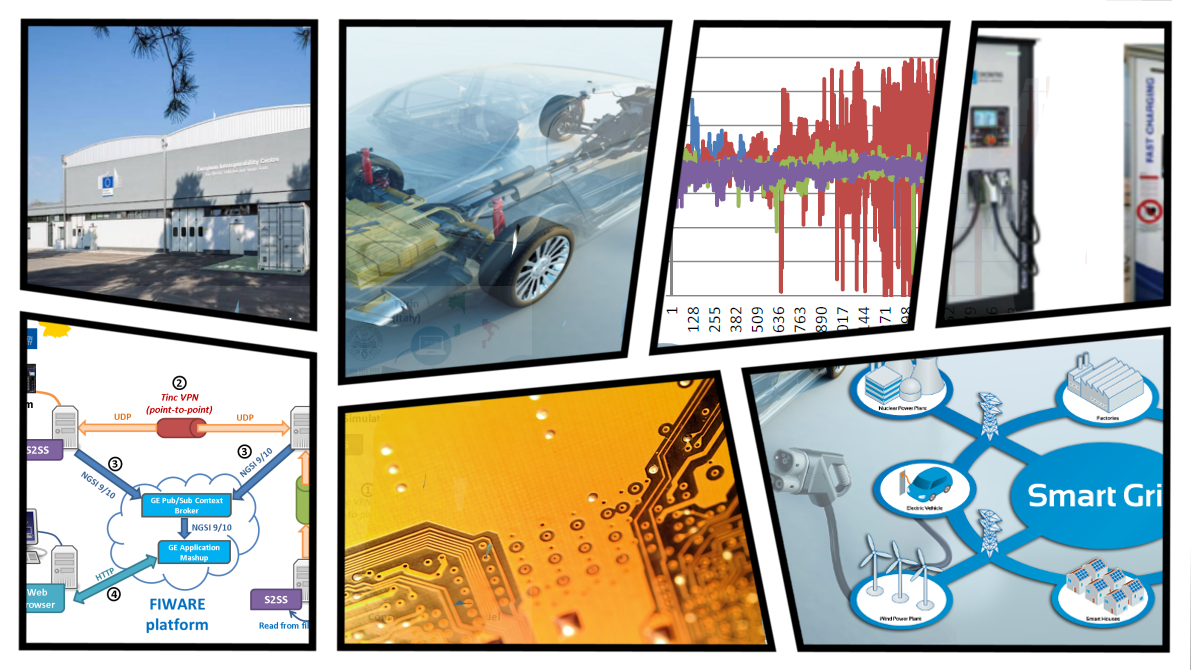
The anticipated benefits stemming from smart, digital grids cannot materialise without guaranteeing appropriate levels of interoperability - i.e. the ability of smart grid actors, components and applications to work together by exchanging data and information.
The next-generation electricity grid is expected to integrate interoperable technologies – particularly in the energy, transport, information and communication fields, including: electric mobility solutions, demand response techniques, Artificial Intelligence, distributed ledger technologies / blockchains, storage devices, distributed energy generators – with the aim to increase reliability, affordability and sustainability of grid and market operations.
As an example, the rated power of fast chargers, their expected operation during peak hours, their clustering and interoperability raise significant concerns. On one hand standards are required for power quality, especially harmonic distortion due to the use of power electronics connecting to high loads. On the other hand, infrastructure dimensioning and design limitations for those investing in such facilities need to be considered.
A unified approach towards a European framework for developing interoperability testing specifications is still missing. To this end, in our laboratories we systematically test and quantify the digital grid interoperability through real world implementations. The establishment of an integrated distributed laboratory will facilitate the modelling, testing and assessment of power systems beyond the capacities of each single entity, enabling remote access to software and equipment anywhere in the EU.
Role
Against this background:
- We established a Smart Grid Interoperability Laboratory within a European Interoperability Centre for Electric Vehicles and Smart Grids. The Smart Grid Interoperability Laboratory, deployed in the JRC Ispra (IT) and Petten (NL) sites, supports the development of EU policies by testing of the interoperability of devices and systems according to the applicable standards and with reference to relevant architecture and use cases. The Smart Grid Interoperability Laboratory: tests the interoperability of solutions, from the market and from research projects; promotes the use of a common interoperability testing methodology based on the CEN-CENELEC-ETSI framework; networks with other European laboratories and research centres for common initiative; networks with European industrial actors in various sectors; disseminates the results of testing campaigns.
- We work at proposing a Code of Conduct to the energy smart appliances manufacturers. The design of Code of Conduct addresses two main challenges: The definition of the principles for data sharing among appliances, home & building automation systems, EV chargers, aggregators, DSOs; The development of Interoperability requirements for energy smart appliances.
- We look into interoperability issues between the electric vehicles and the charging infrastructure, covering hardware and information exchange protocols. In particular, we assess EV fast charging devices' performances in different conditions and scenarios. Exposing electric vehicles to extreme temperatures limits their driving and charging performances. For the foreseen adoption of EVs not only it is important to study the technology behind it, but also the environment it will be inserted in. In Europe, temperatures ranging from -30 °C to +40 °C are frequently observed and the impacts on batteries are well known. However, the impact on the grid due to the performance of fast chargers under such conditions also requires analysis, as it affects both on the infrastructure’s dimensioning and design.
- We compiled best practices in a unified smart grid interoperability testing methodology, comprising of activities, inputs and outputs, and considering a wide range of smart grid implementations. We propose a detailed test set up, by designing an extensive template for the Basic Application Interoperability profile to be used as an interoperability testing protocol. The test specifications are created to guide the stakeholder through a step by step process by setting the Equipment under Test, the System under Test and the control/measuring equipment. The whole process is automated through an open source platform, the Smart Grids SGDOIT platform, which can be used as a common reference.
- We test interoperability in the context of Demand Side Management and Flexibiity Services provision. The two steps indicated in the Interoperability Testing Methodology have been followed: First, the Demand Side Management test bed was built and tested from scratch. We have realised and tested an end-to-end small scale system in the lab from the customer to the energy provider and the DSM concept has been followed by achieving communication between consumer-energy provider. Remote load control has been accomplished. Afterwards, the first interoperability test was carried out by embedding a new smart meter. Three interoperability layers have been tested. The importance of a DSM program has been highlighted and its feasibility has been proved emphasizing on the customers' involvement and active participation in reducing consumptions.
- We study the opportunities and challenges of deploying blockchains and distributed ledger technologies in the energy sector. These tehcnologies indeed promise to support several European Union’s climate-neutrality and sustainability policies, thanks to their potential to drastically change the market rules, and streamline the decision-making processes and the system management mechanisms. Among the main challenges for regulating the blockchain deployment in the electricity sector, one can consider the following ones: to balance technical innovation with the scalability of solutions, to define and allocate decentralised responsibilities of electricity supply and distribution; to incentivise consumers to invest in flexibility technologies; to find a balance between consumer empowerment (self-responsibility) and protection.
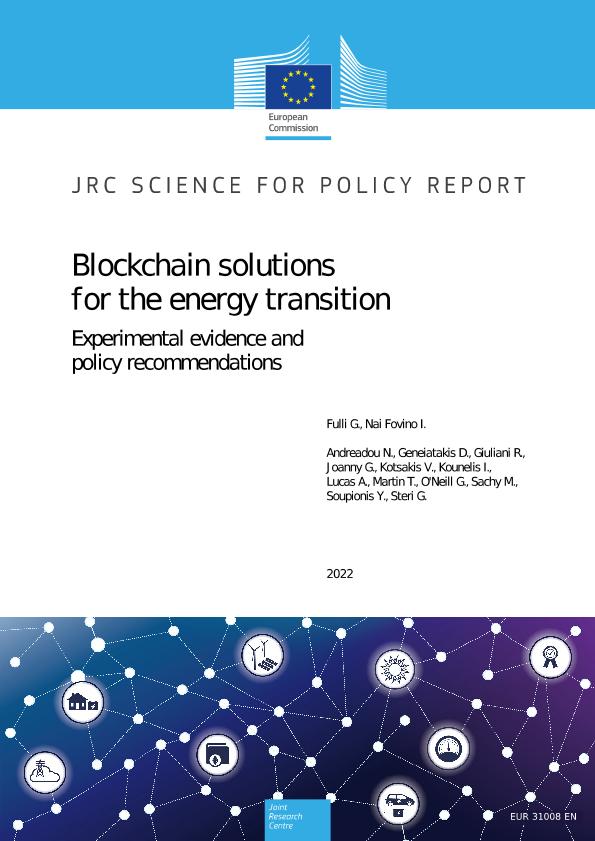
2021 - Blockchain solutions for the energy transition: experimental evidence and policy recommendations
This report confirms that blockchain has high potential for use as the ‘distributed driving brain’ of an energy community, a concept that would radically change the energy sector.
Five different experimental use-cases were tested and analysed: Smart metering, billing and security Fostering of energy communities Certification of origin of energy production Support the implementation of flexibility services Electro mobility scenarios.
These use-cases were studied as they were considered the most technically meaningful for testing the potential of blockchain. Drawing upon the desktop and experimental research conducted, the report offers recommendations to address emerging trends and issues.
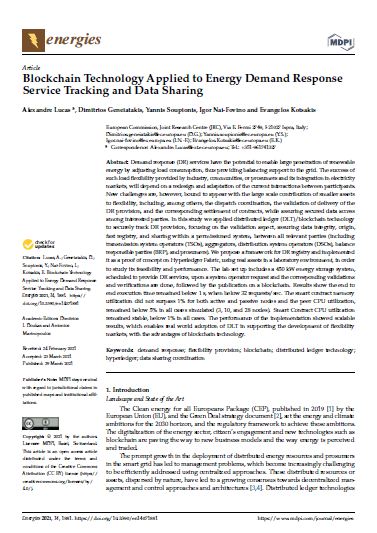
2021 - Blockchain Technology Applied to Energy Demand Response Service Tracking and Data Sharing
In this study we applied distributed ledger (DLT)/blockchain technology to securely track Demand Response provision, focusing on the validation aspect, assuring data integrity, origin, fast registry, and sharing within a permissioned system, between all relevant parties. We propose a framework for DR registry and implemented it as a proof of concept on Hyperledger Fabric, using real assets in a laboratory environment, in order to study its feasibility and performance.
The lab set up includes a 450 kW energy storage system, scheduled to provide DR services, upon a system operator request and the corresponding validations and verifications are done, followed by the publication on a blockchain. The performance of the implementation showed scalable results, which enables real world adoption of DLT in supporting the development of flexibility markets, with the advantages of blockchain technology.
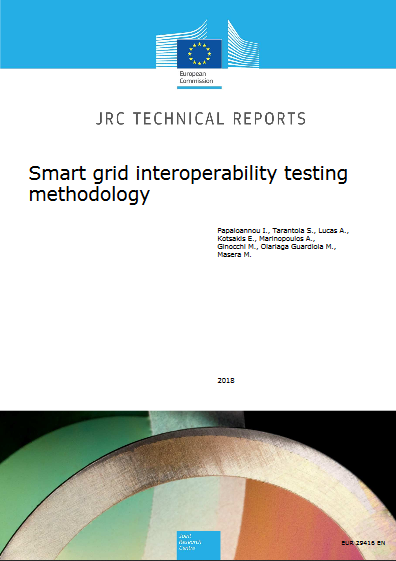
2021 -The integration of dynamic demand in electricity markets: Blockchain 3.0
This report provides an analysis of digital transformation (DT) in a selection of policy areas covering transport, construction, energy, and digital government and public administration. DT refers in the report to the profound changes that are taking place in all sectors of the economy and society as a result of the uptake and integration of digital technologies in every aspect of human life.
Digital technologies are having increasing impacts on the way of living, of working, on communication, and on social interaction of a growing share of the population. For each of the four sectors that are covered, the report presents an overview of DT, DT enablers and barriers, its economic and social impacts, and concludes with the way forward for policy and future research.
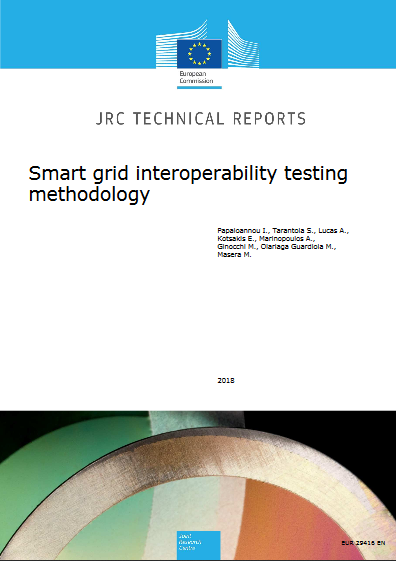
2018 - Smart grid interoperability testing methodology
This report proposes a methodological framework for interoperabilty testing in the smart grid field. Smart grid interoperability is an important enabling aspect of electricity technology deployments. It involves all parts of the smart grid from generation to transmission and from distribution to consumption. Testing interoperability requires producing detailed test cases describing how smart grid components are intended to interact with each other.
A systematic approach for developing smart grid interoperability tests may facilitate the dissemination of innovative solutions, the stability and resilience of the smart grid. This report provides an analysis of the methods applicable to smart grid interoperability tests. It comprises the body of methods and principles associated with smart grid interoperability and it proposes a methodology offering theoretical underpinning to the necessary set of methods and best practices for developing successfully smart grid interoperability testing specifications.
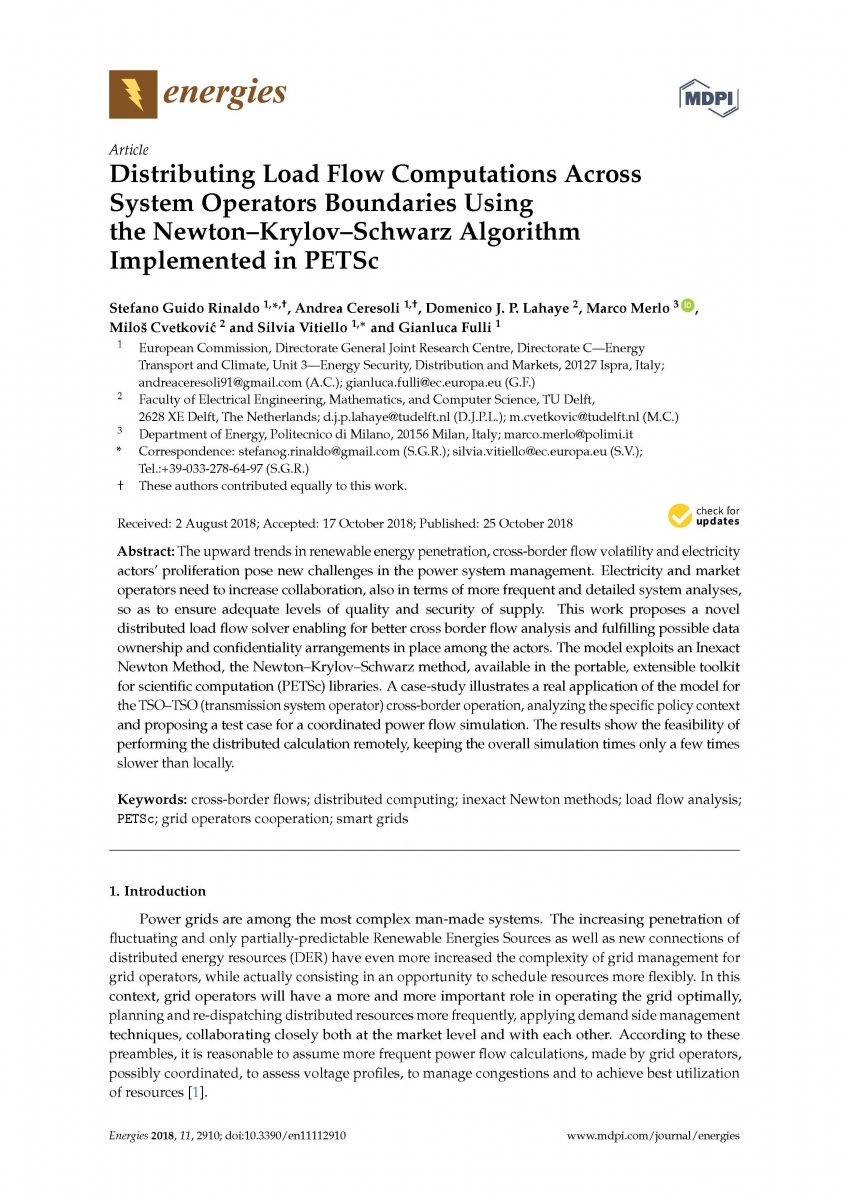
2018 - Distributing Load Flow Computations Across System Operators Boundaries
This paper proposes a novel distributed load flow solver enabling for better cross border flow analysis and fulfilling possible data ownership and confidentiality arrangements in place among the actors. The upward trends in renewable energy penetration, cross-border flow volatility and electricity actors’ proliferation pose new challenges in the power system management. Electricity and market operators need to increase collaboration, also in terms of more frequent and detailed system analyses, so as to ensure adequate levels of quality and security of supply.
The model exploits an Inexact Newton Method, the Newton–Krylov–Schwarz method, available in the portable, extensible toolkit for scientific computation (PETSc) libraries. A case-study illustrates a real application of the model for the TSO–TSO (transmission system operator) cross-border operation, analyzing the specific policy context and proposing a test case for a coordinated power flow simulation. The results show the feasibility of performing the distributed calculation remotely, keeping the overall simulation times only a few times slower than locally.
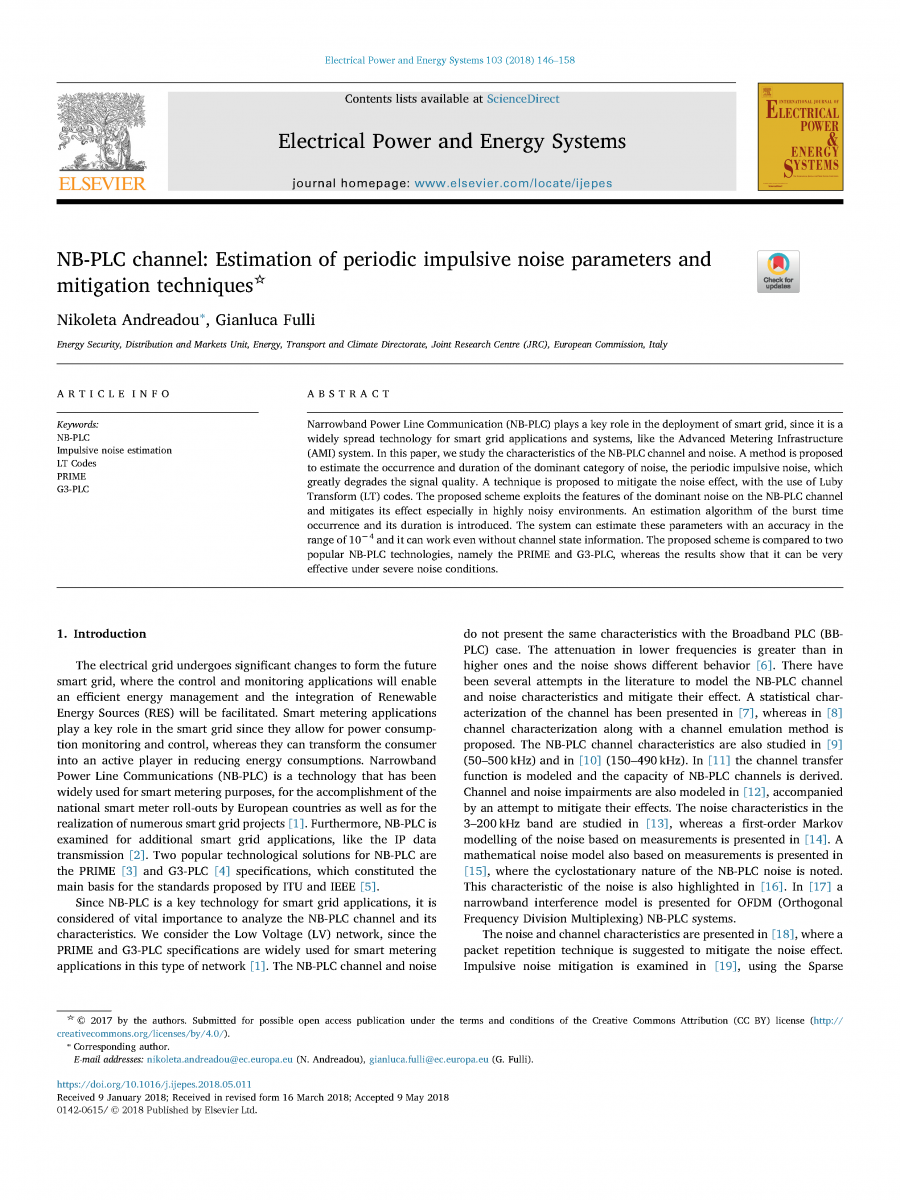
2018 - NB-PLC channel: Estimation of periodic impulsive noise parameters and mitigation techniques
This paper proposes a method to estimate the occurrence and duration of the dominant category of noise, the periodic impulsive noise, which greatly degrades the signal quality. Narrowband Power Line Communication (NB-PLC) plays a key role in the deployment of smart grid, since it is a widely spread technology for smart grid applications and systems, like the Advanced Metering Infrastructure (AMI) system. In this paper, we study the characteristics of the NB-PLC channel and noise. A technique is proposed to mitigate the noise effect, with the use of Luby Transform (LT) codes. The proposed scheme exploits the features of the dominant noise on the NB-PLC channel and mitigates its effect especially in highly noisy environments. An estimation algorithm of the burst time occurrence and its duration is introduced. The system can estimate these parameters with an accuracy in the range of 10−4 and it can work even without channel state information. The proposed scheme is compared to two popular NB-PLC technologies, namely the PRIME and G3-PLC, whereas the results show that it can be very effective under severe noise conditions.
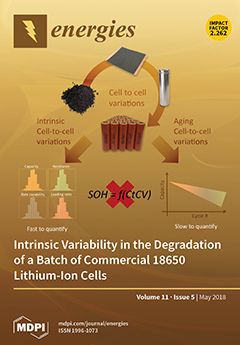
2018 - Smart Meter Traffic in a Real LV Distribution Network
This paper examines the smart meter traffic that needs to be accommodated by a real distribution system. Parameters such as the message size and the message transmission frequency are examined and their effect on traffic is showed. Limitations of the system are presented, such as the buffer capacity needs and the maximum message size that can be communicated. For this scope, we have used the parameters of a real distribution network, based on a survey at which the European Distribution System Operators (DSOs) have participated. For the smart meter traffic, we have used two popular specifications, namely the G3-PLC–“G3 Power Line communication” and PRIME–acronym for “PoweRline Intelligent Metering Evolution”, to simulate the characteristics of a system that is widely used in practice. The results can be an insight for further development of the Information and Communication Technology (ICT) systems that control and monitor the Low Voltage (LV) distribution grid. The paper presents an analysis towards identifying the needs of distribution networks with respect to telecommunication data as well as the main parameters that can affect the Inverse Fast Fourier Transform (IFFT) system performance. Identifying such parameters is consequently beneficial to designing more efficient ICT systems for Advanced Metering Infrastructure.
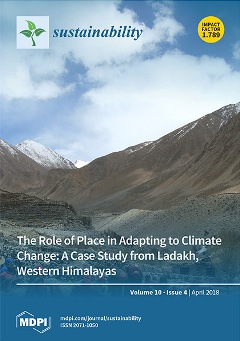
2018 - A DSM test case applied on an end-to-end system, from consumer to energy provider
This paper describes a small scale system, built and tested in our lab, which represents a real end-to-end system from the consumer to the energy provider. Real-time informed consumers can offer the needed flexibility through modifying their behaviour or by engaging with Demand Side Management (DSM) programs. The latter requires the intervention of several actors and levels of communication management which makes this task difficult from an implementation perspective. We programmed the system according to the Object Identification System (OBIS) specification to obtain consumers’ consumption through smart meters with high frequency (one minute). This allows remote control of their appliances in order to reduce the total neighbourhood consumption during critical time periods of the day (peak time). These results and the realisation of a realistic end-to-end system open the way to more complex tests and particularly to the possibility of benchmarking them with other lab tests.
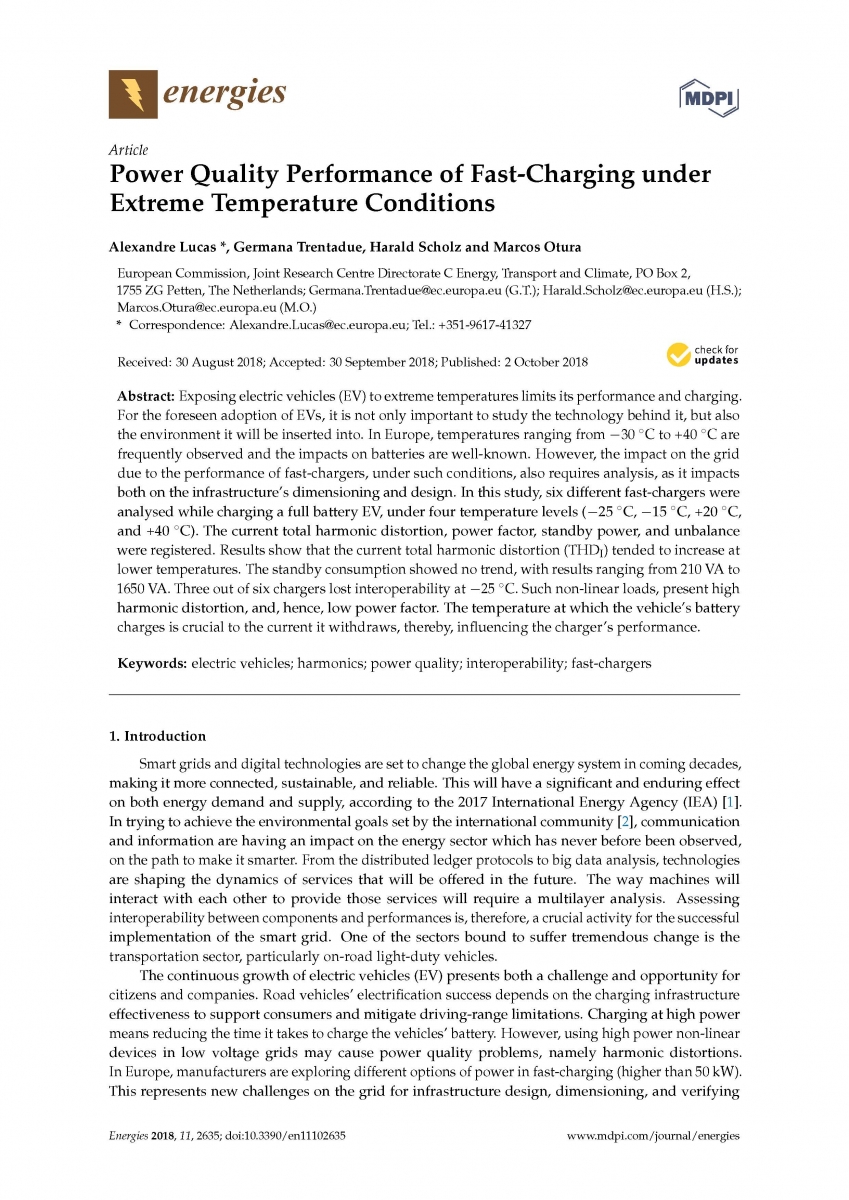
2018 - Power Quality Performance of Fast-Charging under Extreme Temperature Conditions
This paper analyses six different fast-chargers while charging a full battery EV, under four temperature levels (−25 °C, −15 °C, +20 °C, and +40 °C). Exposing electric vehicles (EV) to extreme temperatures limits its performance and charging. For the foreseen adoption of EVs, it is not only important to study the technology behind it, but also the environment it will be inserted into. In Europe, temperatures ranging from −30 °C to +40 °C are frequently observed and the impacts on batteries are well-known. However, the impact on the grid due to the performance of fast-chargers, under such conditions, also requires analysis, as it impacts both on the infrastructure’s dimensioning and design. The current total harmonic distortion, power factor, standby power, and unbalance were registered. Results show that the current total harmonic distortion (THDI) tended to increase at lower temperatures. The standby consumption showed no trend, with results ranging from 210 VA to 1650 VA. Three out of six chargers lost interoperability at −25 °C. Such non-linear loads, present high harmonic distortion, and, hence, low power factor. The temperature at which the vehicle’s battery charges is crucial to the current it withdraws, thereby, influencing the charger’s performance.
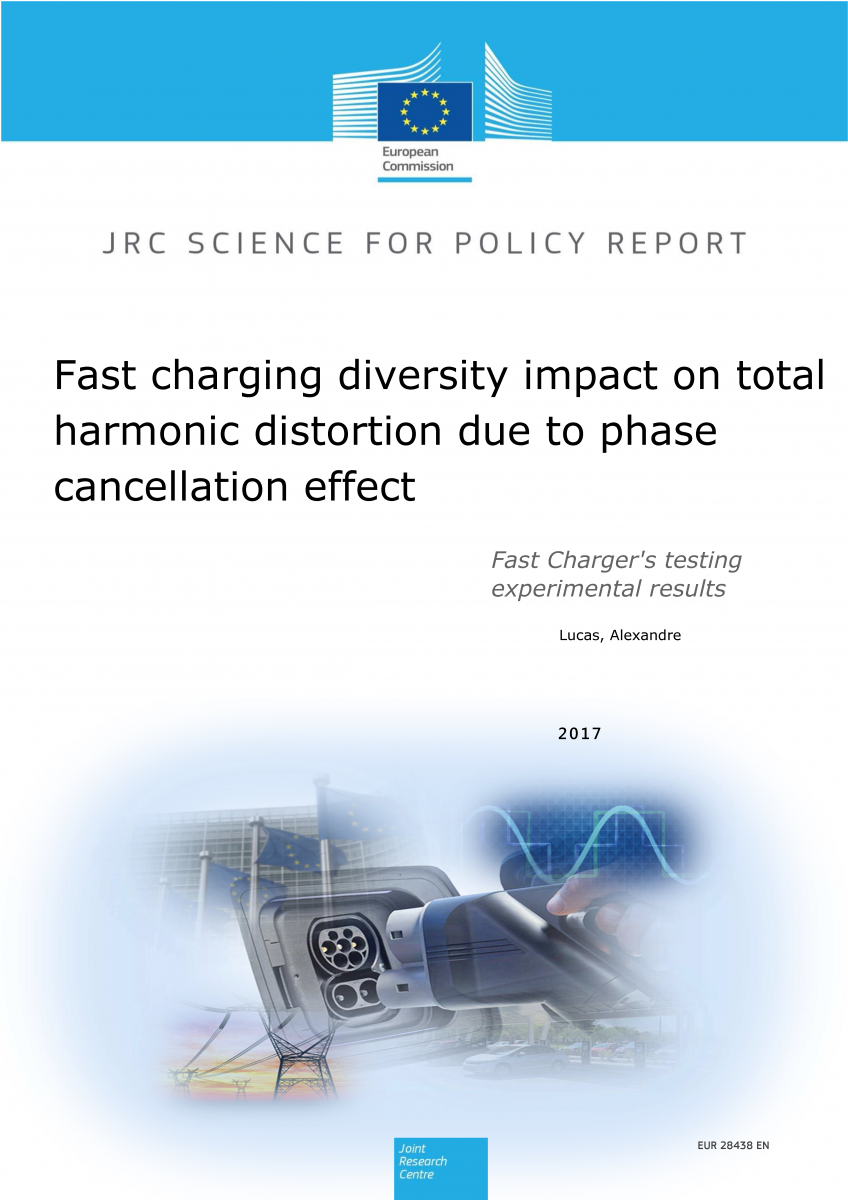
2017 - Fast charging diversity impact on total harmonic distortion due to phase cancellation effect
This report analyses performances and impact on power quality of different fast chargers for electric vehicles.
Full charging cycles were performed in the studied chargers and THDV and THDI were observed. From the measurements it can be observed that the phase angles vary within a preferential range, i.e. remain within a range which is actually <90˚of amplitude.
Two of the Chargers, working individually, failed to comply with the standards. Charger A barely makes it in terms of TDD and Charger C is out of the limit. In terms of individual harmonics also Charger A and Charger C are out of the limit of 4.5% for the 11th and 13th harmonics.
The next step of the research will be to obtain the statistical distribution of each of the phase angles for all Chargers and perform simulations with different scenarios. Results so far suggest that stand alone Chargers with low short circuit values are recommended to have filters <13% THD.
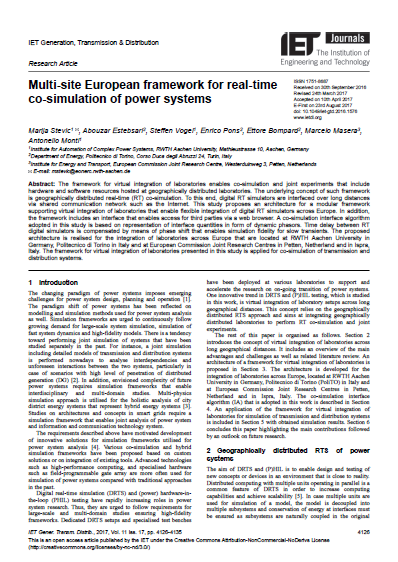
2017 - Multi-site European framework for real-time co-simulation of power systems
This paper describes a framework for virtual integration of laboratories enables co-simulation and joint experiments that include hardware and software resources hosted at geographically distributed laboratories. The underlying concept of such framework is geographically distributed real-time (RT) co-simulation. To this end, digital RT simulators are interfaced over long distances via shared communication network such as the Internet. This study proposes an architecture for a modular framework supporting virtual integration of laboratories that enable flexible integration of digital RT simulators across Europe. In addition, the framework includes an interface that enables access for third parties via a web browser. A co-simulation interface algorithm adopted in this study is based on representation of interface quantities in form of dynamic phasors. Time delay between RT digital simulators is compensated by means of phase shift that enables simulation fidelity for slow transients. The proposed architecture is realised for the integration of laboratories across Europe that are located at RWTH Aachen University in Germany, Politecnico di Torino in Italy and at European Commission Joint Research Centres in Petten, Netherland and in Ispra, Italy. The framework for virtual integration of laboratories presented in this study is applied for co-simulation of transmission and distribution systems.
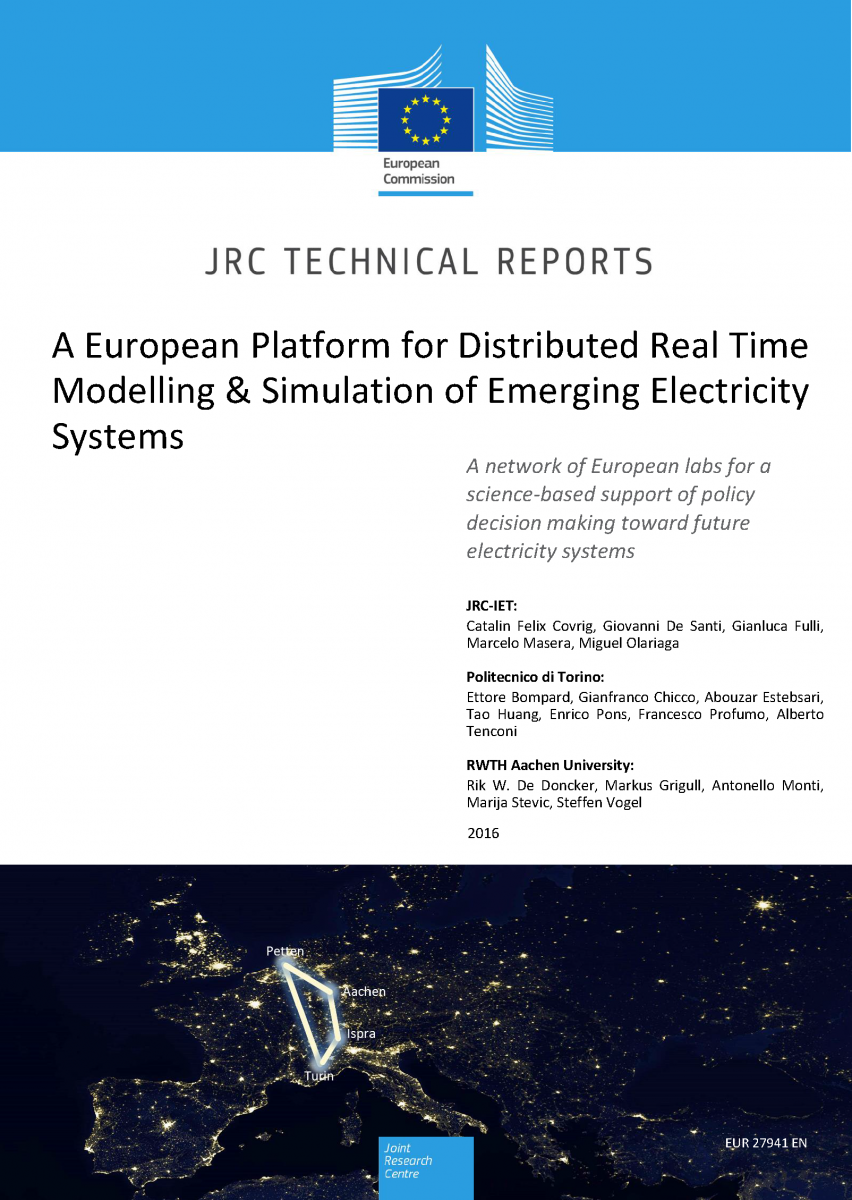
2016 - A European Platform for Distributed Real Time Modelling & Simulation
This report presents the proposal for the constitution of a European platform consisting of the federation of real-time modelling and simulation facilities applied to the analysis of emerging electricity systems. Such a platform can be understood as a pan-European distributed laboratory aiming at making use of the best available relevant resources and knowledge for the sake of supporting industry and policy makers and conducting advanced scientific research.
The report describes the need for such a platform, with reference to the current status of power systems; the state of the art of the relevant technologies; and the character and format that the platform might take. This integrated distributed laboratory will facilitate the modelling, testing and assessment of power systems beyond the capacities of each single entity, enabling remote access to software and equipment anywhere in the EU, by establishing a real-time interconnection to the available facilities and capabilities within the Member States.
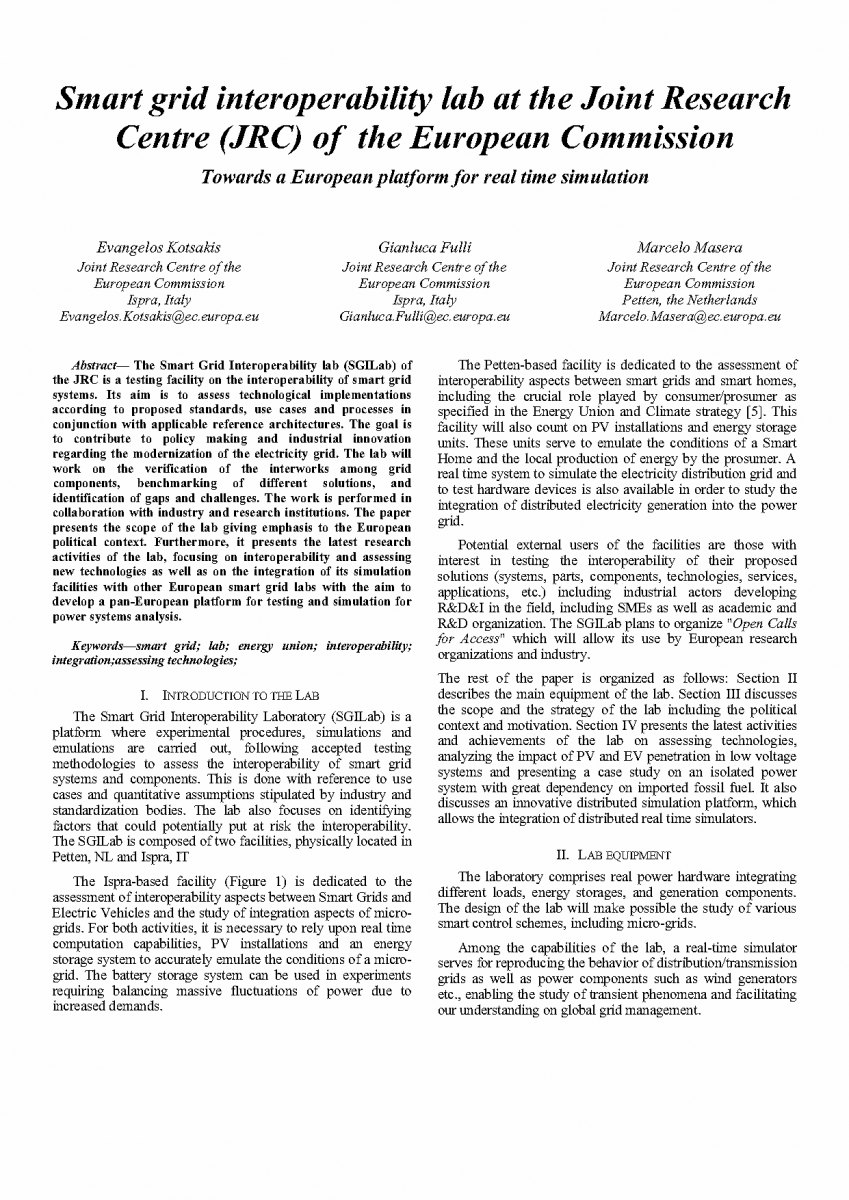
2016 - Smart Grid Interoperability lab at the JRC
This paper presents the scope of the Smart Grid Interoperability lab of the JRC. The lab is a testing facility on the interoperability of smart grid systems and its aim is to assess technological implementations according to proposed standards, use cases and processes in conjunction with applicable reference architectures. The goal is to contribute to policy making and industrial innovation regarding the modernization of the electricity grid.
The lab will work on the verification of the interplay among grid components, benchmarking of different solutions, and identification of gaps and challenges. The work is performed in collaboration with industry and research institutions.
The paper presents the latest research activities of the lab, focusing on interoperability and assessing new technologies as well as on the integration of its simulation facilities with other European smart grid labs with the aim to develop a pan-European platform for testing and simulation for power systems analysis. Emphasis is given to the European political context.
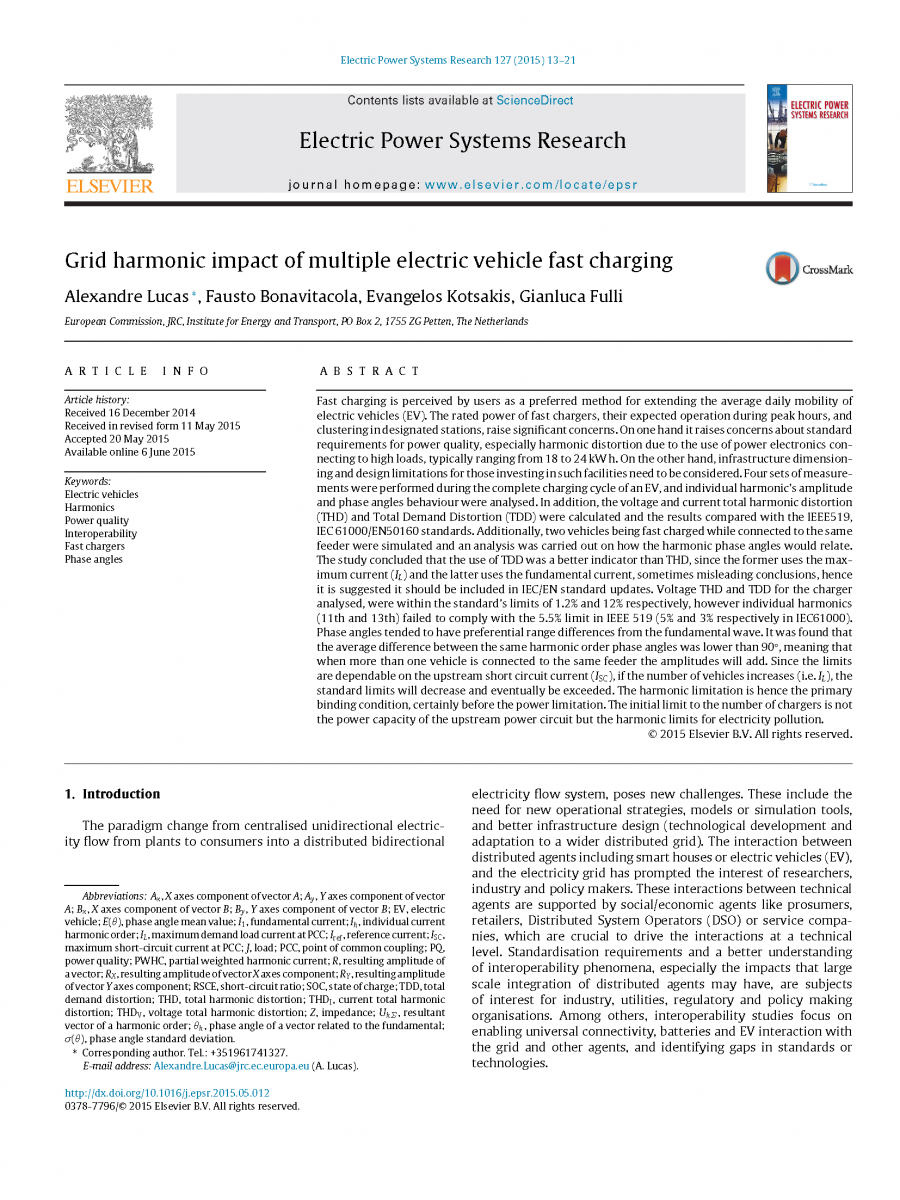
2015 - Grid harmonic impact of multiple electric vehicle fast charging
This paper reports results from four sets of measurements performed during the complete charging cycle of an EV, and analyses individual harmonic’s amplitude and phase angles behaviour. In addition, the voltage and current Total Harmonic Distortion (THD) and Total Demand Distortion (TDD) are calculated and the results compared with the IEEE519, IEC 61000/EN50160 standards. Additionally, two vehicles being fast charged while connected to the same feeder are simulated and an analysis is carried out on how the harmonic phase angles would relate. The study concludes that TDD is a better indicator than THD, since the former uses the maximum current (IL) and the latter uses the fundamental current, sometimes misleading conclusions, hence it is suggested it should be included in IEC/EN standard updates. Voltage THD and TDD for the charger analysed, were within the standard’s limits of 1.2% and 12% respectively, however individual harmonics (11th and 13th) failed to comply with the 5.5% limit in IEEE 519 (5% and 3% respectively in IEC61000). Phase angles tended to have preferential range differences from the fundamental wave. It was found that the average difference between the same harmonic order phase angles was lower than 90°, meaning that when more than one vehicle is connected to the same feeder the amplitudes will add. Since the limits depend on the upstream short circuit current (ISC), if the number of vehicles increases (i.e. IL), the standard limits will decrease and eventually be exceeded. The harmonic limitation is hence the primary binding condition, certainly before the power limitation. The most binding limit to the number of chargers is not the power capacity of the upstream power circuit but the harmonic limits for electricity pollution.
